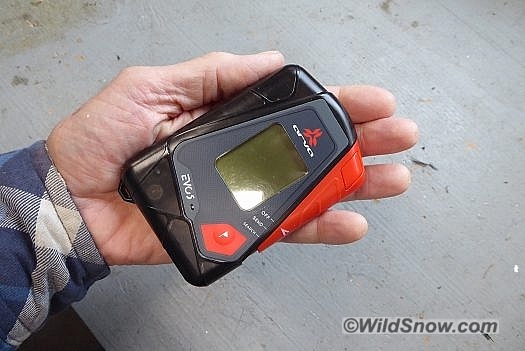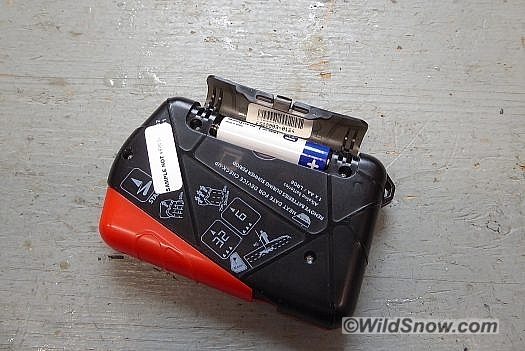From Lou, 10/13/2019
Dear readers, when I tested the pre-production sample of this beacon, the mode switch in my opinion moved too easily from Search to Send. I’ve become more discerning about this after doing beacon drills over the past couple of years. With more than a few people, with different skill levels, such drills seemed to almost always get messed by a beacon or two accidentally being switched from Search to Send.A few days ago I received a retail version of the Evo5. I measured the resistance of the switch, using my force gauge, and saw virtually no difference (it moves with a force of about 14.7n). But the switch does feel slightly more difficult to move, probably because of the way it interacts with the pressure of my hand (hard to measure with linear constraint of my gauge). I’m going to change the conclusion of this review to “recommended with caveat, both regarding the switch and the auto-revert-to-transmit.”
There is another point I should clarify. This issue with ease of switching is a new one for my reviews. From this point forward I’ll hold all beacons accountable in this regard, and be sure to mention test results as well as feel. Likewise, I’ve become more concerned about automatic-revert-to-transmit. More on both these issues below.
So, in a nutshell, the size and functionality of the Evo5 is compelling. If you’re considering it along with a few other choices, be sure to note the switch detente on the other units. Some are not much different, though I hope to see that change. (One does wonder if there might be a European standard that requires these Search-to-Send switches to move so darn easily. I’ve got queries out about that.)
It began at the dawn of humanity when flint knappers made the smallest knives and arrow points possible for their tribe’s non-mechanized hunters — and continues to the present, as phones thin, batteries lean, living space shrinks — and human power takes the moral highground. The quest for miniaturization: as part of human endeavor as, procreation? Not quite. But, almost?
We’ll leave the worldly questions to those of you who care for philosophy, and have brains with the resilience to handle universal questions of existence. Meanwhile, back at the ranch:
I got a package in the mail. It was a small package. Inside was an Arva Evo5 avalanche transceiver, by a long shot the most compact low-mass avalanche rescue transceiver the French company has ever made. At a palm and pocket friendly 11×7 centimeters, it’s also one of the smallest rigs in the entire market. 164 grams with battery, excluding holster.
Follow along as I do my first fiddle with this attractive but pesky little thing:
– First, Arva’s design philosophy here is obvious: Keep it simple, small, and light.
– You control the Evo5 with a slider switch and a single button marked with a flag icon. While _in transmit mode_ a lock button prevents accidental switching. Slide farther, you hit search mode. The slider switch _does not lock or otherwise “snap” into search mode_. Move it a small distance (requires minimal force) and bam, you’re back to transmitting. I measured the force required to move the switch, as illustrated above, minimal at an average of 14.72n measured with my force gauge. The retail unit feels slightly better, but I’ve got a pet peeve about this and would like to see beacons that are difficult to switch by accident — between any two modes.
A slider switch can be knocked back to transmit while roughly handled during a search, and possibly while re-holstering. (For those new to avalanche companion rescue, non-victim beacons in transmit mode confuse searches, sometimes terribly — and in real-life, tragically.) As mentioned above but bears repeating, at least one other brand/model beacon has had a similar problem, test test test any beacon you consider purchasing, be unforgiving.)
Moving along… I’m a fan of configuring (or ideally, disabling) automatic revert to transmit (AR). There is nothing in the manual about changing the automatic AR of the Evo5. So for now, know that out of the box the Evo5 is set with an AR of eight minutes (while moving, or still). Eight minutes is too short in my opinion. But I can live with it.
As you’re searching, every eight minutes the rig will return to transmit (with an audible signal) UNLESS you press the marking button to indicate you are not a victim. It’s not hard to see the problem here. For example, say you have a guided group and some of your clients are inactive during a search, so you simply turn their beacons to Search mode and tell them to cool it. They zip up their jackets and do as requested. Eight minutes later they hear some beeping from under their coats. The beacon is returning to transmit. Most are emotionally stressed, and if they ever did really know how to cancel the AR, they don’t do so. Result, instant confusion.
One other thing about AR. When it happens to your beacon in the middle of a heated search, it’s disruptive. Not what you need when you’re in near panic.
Beacons with optional AR are perhaps a better choice (video). But if you’re on top of your gear, and practice, you can make Evo5 work. I’d advise not issuing it to clients in an institutional setting, however. As a mountain guide with clients, I’d want the choice of having AR, or not.
Again along the lines of switch operation, it’s too bad switching the Evo5 from search to send isn’t as hard as turning it off. To power down, rather than simply moving the locked slider from “SEND” to “OFF,” you also have to hit the circular red “flag” button on the front of the unit. The idea here: accidental switching-to-off is impossible occurrence. I’m not understanding why the locking slider switch isn’t enough — it is solid when locked in send/transmit mode, impossible to accidentally switch off, and impossible to switch to search mode. And yeah, I think this “feature” is a concern. Why? Simply because it is “bad UI,” i.e., changing an intuitive interface to something that requires guesswork or memorization.
– Now that I’ve satisfied readers who request BALANCED reviews, on to the good stuff. This is a three antenna rig. That means it works for “point and shoot” searching in the hands of nearly anyone. Further, it’s got a claimed 50 meter range (remember real-life “range” depends on a host of factors, some out of your control). Other beacons may boast of more range, but in my view 50 meters is plenty.
Of lesser importance to many of us, but still good so long as it doesn’t junk up the display (it doesn’t), you get a mark function for that time you’re in Zermatt and run across an avalanche that’s scoured twelve people off a ski run. Or can be used for the more common task of adding complexity and fun to your practice sessions. I’ve found the multiple-burial marking features on some beacons to add clutter to the display, while the Evo5 tends to be crisp and simple.
– I like the use of a single AA battery. Simple, light, easy to replace. When you power up, you get a battery capacity percentage. Swap in a new AA when it reads below 50 percent, so you have plenty of juice for searching. Use the half-depleted cell in your cordless mouse.
Downside here: unlike certain other models-brands, the Evo5 battery compartment is not moisture sealed. I’ve never required that level of water resistance in a beacon, but it’s a nice feature if you tend to leave your rig buried in a rucksack full of wet gear, or you carry it in a pocket where it gets lots of humidity.
Conclusion: I love the form factor and simplicity of the Evo5, but prefer a beacon that’s more difficult to switch from Search mode to Send, perhaps has an audible signal while doing so. I also prefer a unit with automatic revert-to-transmit that that can be used by choice. It should also be noted the Evo5 does not have an audible signal after being left on for excessive time (battery saver). Would I use the Evo5? Yes, with all the above in mind.
(Tips: With any avalanche beacon smear a small amount of dielectric grease on the battery terminals, to prevent moisture problems. And don’t forget the cost-effective zero-weight grade-64 waterproofing you get with a ziplock baggie.)
Other features:
– Backlit screen (mandatory for any beacon, in my opinion).
– Group check (yawn).
– Audible search signal (again, mandatory).
– “Interference Management” for those times you do a beacon search under power lines.
– Marking function.
Evo5 will be available fall of 2019, around $300.00 with a nicely appointed holster-harness. Shop for it here.
WildSnow.com publisher emeritus and founder Lou (Louis Dawson) has a 50+ years career in climbing, backcountry skiing and ski mountaineering. He was the first person in history to ski down all 54 Colorado 14,000-foot peaks, has authored numerous books about about backcountry skiing, and has skied from the summit of Denali in Alaska, North America’s highest mountain.


